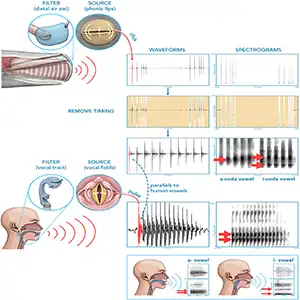
Breakthrough declared in deciphering whale language and their 'click code'
Sperm whales near Dominica may be saying far more in their clicks than scientists once believed. After examining more than 1,000 recordings, researchers made a striking discovery.
The whales consistently produce vowel-like sound types within their codas. These are brief click sequences used for social communication.
The study, led by linguist Gasper Beguš at the University of California, Berkeley, hints that these giant marine mammals could be shaping their clicks with a sophistication that edges closer to language.
Listening to whale clicks
Caribbean sperm whales exchange patterns of clicks called codas – short clustered signals used mainly in social communication rather than for hunting.
Each coda is a brief sequence, often only a fraction of a second long, that can be repeated many times during a group conversation.
Earlier studies off Dominica showed that sperm whales live in social units marked by dialects. These dialects are distinct click repertoires that signal clan identity.
Researchers mostly summarized codas by the number of clicks and the timing between them. They left the detailed sound quality in the background.
Whales pack meaning into clicks
The study focuses on spectral patterns – frequency-based fingerprints that describe how energy is spread across a sound.
When the team compressed the gaps between clicks and sped up the audio, new regular structures appeared that had been hidden in earlier analyses.
They discovered that many codas show one or two stable formants, resonant frequency bands that help distinguish different vowel sounds in speech.
Codas with a single low formant roughly match an a-type pattern, while codas with two separated formants resemble an i-type pattern.
Some codas show moving formants that glide up or down, creating patterns similar to diphthongs – vowel sounds that change quality within a syllable.
These patterns suggest sperm whales layer multiple kinds of information into one click burst, not simple codes.
Proof the vowels are real
To test whether the vowel-like patterns were real or just artifacts, accidental features created by recording equipment – the team rechecked details of recordings.
They compared clicks made at different depths and body positions and still saw codas switching cleanly between a-type and i-type patterns.
Within a single coda, every click usually belonged to the same vowel type, producing a discrete, sharply separated pattern rather than a smooth blend.
If the differences had come only from chance or movement, the researchers would have expected many mixed codas. Instead, they saw tidy groupings.
Anatomical work on ear ossicles, tiny bones that pass sound inward, shows that sperm whales can detect frequencies above 30 kilohertz.
That sensitivity lines up with the ranges where the new coda vowels sit, which means whales are likely able to hear these differences clearly.

AI uncovers whale signals
Long before the full acoustic analysis, Beguš tested a model called fiwGAN, a neural network that imitates sounds while encoding information.
When trained on human speech recordings, the model automatically organized its internal units in ways that matched real words and sound patterns.
Training a similar network on whale codas made it highlight representations, internal codes that track features it finds useful in timing and tone.
Those hints from artificial intelligence encouraged the human team to look more carefully at the fine-scale spectra of real clicks.
This approach shows how interpretability, the practice of inspecting what a model pays attention to, can guide scientists toward patterns they might otherwise miss.
The network highlighted spectral details, and acoustic tests confirmed that sperm whales use structured, vowel-like codas.
Vowels across the animal world
Across species, bioacoustics, the study of how animals use sound to communicate, shows that formants carry information about identity and body size.
In deer, monkeys, and other mammals, these resonant bands help listeners judge how large another individual is and whether it sounds threatening or friendly.
Experiments with gray seals show vocal learning – the ability to copy and adjust sounds – including subtle shifts in formants learned from human-like models.
If other mammals can consciously alter resonances, it becomes plausible that sperm whales adjust their air spaces to shape coda vowels in flexible ways.
In the codas, timing and vowel type appear partly orthogonal, able to vary independently without affecting each other.
That combinatorial structure suggests the system could encode many different messages. Researchers still do not know what any specific coda means.
Significance of the research
“It was striking just how structured the system was,” said Beguš. For him, the regularity of the patterns hints that whales may organize information in careful ways. Humans still cannot read the code.
If whales use something close to language, ocean noise and hunting raise sharper questions because they can harm communication without causing injury.
“In a sense, language is the last frontier,” said Beguš, who hopes future work will reveal what codas mean in daily whale life. Next steps include comparing coda vowels across whale clans in other oceans.
Researchers also want to track calves as they grow, to learn when and how young animals start matching the adult click patterns.
The study is published in the journal Open Mind.
—–
Like what you read? Subscribe to our newsletter for engaging articles, exclusive content, and the latest updates.
Check us out on EarthSnap, a free app brought to you by Eric Ralls and Earth.com.
—–













